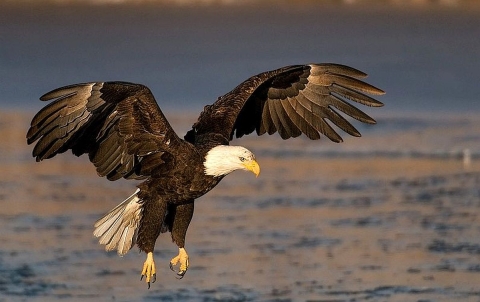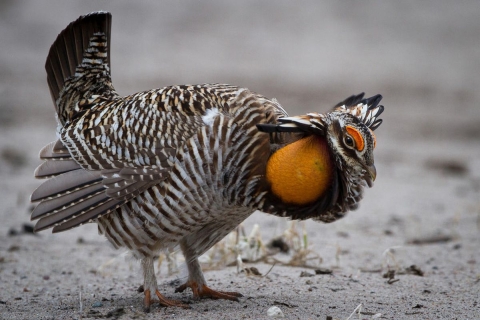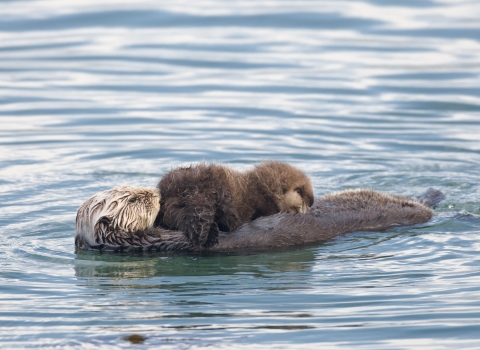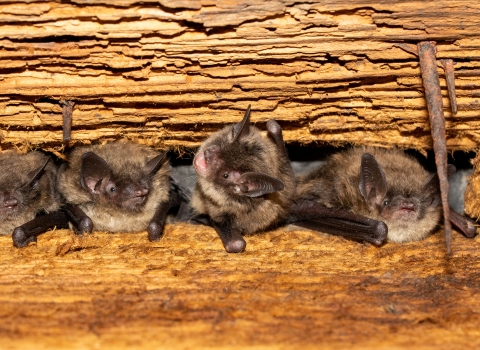Which birds are the best to look for on national wildlife refuges? Those you most like to see. That might mean large-winged birds with flashy mating displays. Or bright-beaked wading birds that are fun to watch feed. Or maybe a small bird that flies record-setting distances each spring. With more than 700 bird species on refuges, you have a wide choice. Here are a few kinds of birds to consider.
1. Bald Eagles
The majestic sight of a bald eagle soaring overhead rarely fails to inspire awe. Our national icon, the bald eagle is woven into the nation’s conservation legacy. The species nearly died out in the mid-20th century because of hunting, pesticide overuse and habitat loss. The banning of DDT in 1972 and passage of the Endangered Species Act in 1973 helped bald eagles survive. By 2007 eagles recovered enough to be removed from the federal list of threatened and endangered species. Eagles today continue to represent fierce independence, resilience and freedom.
Where to Look: Bald eagles can be seen year-round at many of the nation’s more than 560 refuges. Lower Klamath National Wildlife Refuge (CA and OR), Reelfoot National Wildlife Refuge (TN) and Elizabeth Hartwell Mason Neck National Wildlife Refuge (VA) are just a few refuges for great eagle sightings. Winter hotspots include Upper Mississippi National Wildlife and Fish Refuge (IL, IA, WI, MN) and Tule Lake National Wildlife Refuge (CA).
Story: "Eagles Across America"
2. Brown Pelicans
Talk about biting off more than you can chew! It’s fun to watch the brown pelican scoop big fish whole with its distinctive neck pouch. No wonder the bird is immortalized in a well-known limerick:
“A wonderful bird is the Pelican.
His beak can hold more than his belly can.
He can hold in his beak
Enough food for a week
But I'm damned if I see how the helican!”
Pelican Island National Wildlife Refuge in Florida, established in 1903, is the nation’s first wildlife refuge. President Theodore Roosevelt set it aside to protect brown pelicans from slaughter for their plumage. Brown pelicans, once endangered, have made a recovery with the help of refuges.
Where to Look: Brown pelicans typically are seen along coastal areas. They are found at Breton National Wildlife Refuge (LA), Pea Island National Wildlife Refuge (NC), Cape Romain National Wildlife Refuge (SC) and refuges along the Oregon Coast.
3. Eastern Screech Owls
Masters of camouflage, Eastern screech owls are small, stocky night wanderers. By day, they roost in tree cavities – inside which they appear all but invisible. Come night, they are active and on the prowl. Don’t let their name fool you. Their call is typically more a soft whine than it is a screech.
Where to Look: Common on the East Coast, Eastern screech owls can also be found as far north and west as North Dakota. Look for these owls at Okefenokee National Wildlife Refuge (GA), Merritt Island National Wildlife Refuge (FL) and Patuxent Research Refuge (MD). Or better yet, listen for them. You may be more likely to hear one whinny than you are to see one.
4. Attwater’s Prairie Chickens
Look in the tall grass of the coastal plains of Texas, and you might see an Attwater’s prairie chicken pecking for seeds and grains. But, for a real spectacle, see the speckled brown ground bird in mating season. That’s when the male of the species struts its stuff to attract a mate – raises its tail, flaps its wings and inflates its bright yellow air sacs to make a low booming sound.
Where to Look: In spring, go to Attwater Prairie Chicken National Wildlife Refuge (TX) to see male prairie chickens perform their colorful courtship ritual. Their distant relatives, the sage grouse, can be seen at Seedskadee National Wildlife Refuge (WY).
5. Puffins
Puffins live most of their lives at sea. Excellent swimmers, they use their webbed feet to steer through the waves. From the air, they can dive up to 200 feet into the ocean. During breeding season, their beaks and feet turn bright yellow and orange, in stark contrast with their white and black bodies. Puffins return to land in spring and summer to form breeding colonies. Gulls sometimes crowd them out of nesting islands. On refuge islands in the Northeast, critical sanctuaries for puffins, refuge staff keep gulls in check. Refuge efforts to restore food resources, such as herring and other small fish species, are also critical to sustaining the puffin population.
Where to Look: Rocky islands off both the east and west coasts. Puffins are fun to watch and frequent the Maine Coastal Islands National Wildlife Refuges and Alaska Maritime National Wildlife Refuge.
6. Red Knots
Red knots, among the world’s longest-flying migratory birds, travel more than 18,000 miles each year between the Arctic and the Gulf Coast, southeast United States and South America.
Where to Look: In spring, exhausted red knots stop at Cape May National Wildlife Refuge (NJ) and Delaware Bay beaches to gorge on the eggs of spawning horseshoe crabs. The annual spectacle draws thousands of birdwatchers to the area. In just a few days, the birds nearly double their weight to prepare for the final leg of their long journey to their Arctic nesting grounds.
7. Rufous Hummingbirds
If you find yourself in the Pacific Northwest, look for the rufous (rust-colored) hummingbird, plunging its bill deep into the center of a flower. It’s one of the smaller members of the hummingbird family – just over three inches long. But what it lacks in size, it makes up in wing speed (52+ wingbeats per second) and color. The male rufous hummingbird glows deep hues of orange citrine. These small and feisty birds migrate incredible distances (3,900 miles one way) along the western coast of the United States, Canada and Mexico.
Story: Wings of Life
Where to Look: Look for these spectacular birds on the Oregon Islands National Wildlife Refuges.
8. Sandhill Cranes
Dinosaurs may no longer roam the Earth, but you can still see some of their closest surviving relatives feeding in and flying over wet meadows. Sandhill cranes have been around for more than two million years. These graceful, large-winged birds fly up to 50 miles per hour and reach altitudes of up to 12,000 feet.
Where to Look: At Bosque del Apache National Wildlife Refuge (NM) and other places where they winter, you can see them take off in masse from their roosting spots at sunrise, filling the air with their rolling cries. If you’re lucky, you might see pairs raising and lowering their heads in unison as part of a showy mating dance. Refuges provide cranes vital habitat for nesting and rearing young.
9. Snow Geese
HONK! Giant flocks of snow geese fly noisily over refuges in spring and fall.
In the eastern United States, a sharp drop in snow geese numbers led to a hunting ban in 1916. After Blackwater National Wildlife Refuge and other sites conserved snow geese habitat and the birds recovered, the ban was lifted in 1975.
Story: Snow Geese Extravaganza Hits Home (Bay Journal)
Where to Look: The sight of thousands of snow geese attracts birdwatchers to places like Blackwater National Wildlife Refuge (MD) and Loess Bluffs National Wildlife Refuge (MO).
10. Wood Ducks
Look for these colorfully patterned ducks foraging for aquatic plants and seeds along the edges of swamps, rivers and ponds. Males are iridescent green, brown and white. Females are handsome but less colorful. Wood ducks feed by dabbling or making short dives.
Where to Look: Wood ducks are common at Billy Frank Jr. Nisqually National Wildlife Refuge (WA), Black Bayou Lake National Wildlife Refuge (LA), Deep Fork National Wildlife Refuge (OK) and dozens of other refuges.
















